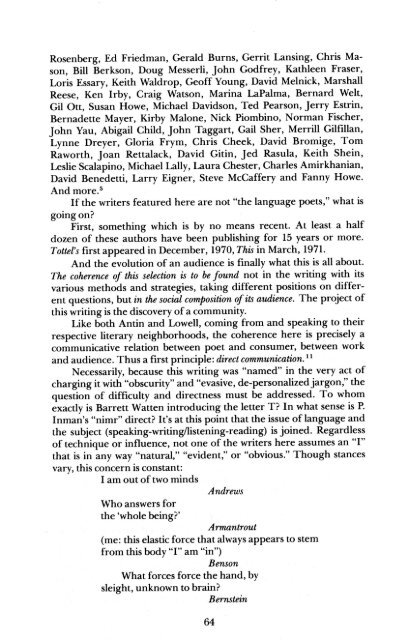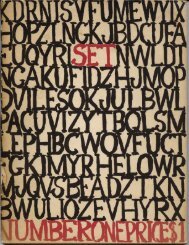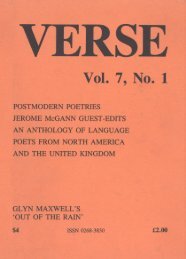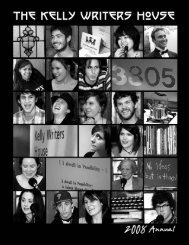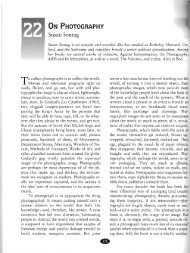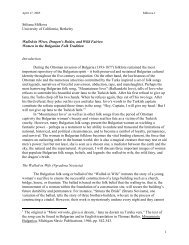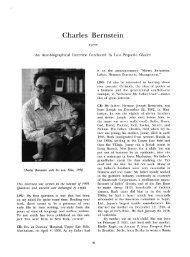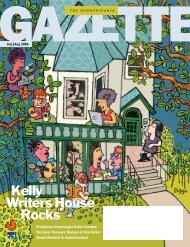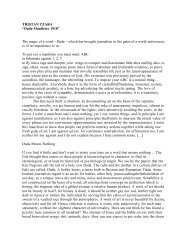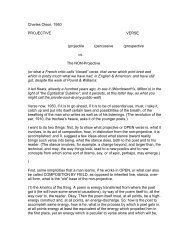Realism: An Anthology of 'Language' Writing
Realism: An Anthology of 'Language' Writing
Realism: An Anthology of 'Language' Writing
Create successful ePaper yourself
Turn your PDF publications into a flip-book with our unique Google optimized e-Paper software.
Rosenberg, Ed Friedman, Gerald Burns, Gerrit Lansing, Chris Mason,<br />
Bill Berkson, Doug Messerli, john Godfrey, Kathleen Fraser,<br />
Loris Essary, Keith Waldrop, Ge<strong>of</strong>f Young, David Melnick, Marshall<br />
Reese, Ken Irby, Craig Watson, Marina LaPalma, Bernard Welt,<br />
Gil Ott, Susan Howe, Michael Davidson, Ted Pearson, jerry Estrin,<br />
Bernadette Mayer, Kirby Malone, Nick Piombino, Norman Fischer,<br />
john Yau, Abigail Child, john Taggart, Gail Sher, Merrill Gilfillan,<br />
Lynne Dreyer, Gloria Frym, Chris Cheek, David Bromige, Tom<br />
Raworth, joan Rettalack, David Gitin, jed Rasula, Keith Shein,<br />
Leslie Scalapino, Michael Lally, Laura Chester, Charles Amirkhanian,<br />
David Benedetti, Larry Eigner, Steve McCaffery and Fanny Howe.<br />
<strong>An</strong>d more. s<br />
If the writers featured here are not "the language poets," what is<br />
going on?<br />
First, something which is by no means recent. At least a half<br />
dozen <strong>of</strong> these authors have been publishing for 15 years or more.<br />
Tottel's first appeared in December, 1970, This in March, 1971.<br />
<strong>An</strong>d the evolution <strong>of</strong> an audience is finally what this is all about.<br />
The coherence <strong>of</strong> this selection is to be found not in the writing with its<br />
various methods and strategies, taking different positions on different<br />
questions, but in the social composition <strong>of</strong> its audience. The project <strong>of</strong><br />
this writing is the discovery <strong>of</strong> a community.<br />
Like both <strong>An</strong>tin and Lowell, coming from and speaking to their<br />
respective literary neighborhoods, the coherence here is precisely a<br />
communicative relation between poet and consumer, between work<br />
and audience. Thus a first principle: direct communication. 11<br />
Necessarily, because this writing was "named" in the very act <strong>of</strong><br />
charging it with "obscurity" and "evasive, de-personalized jargon," the<br />
question <strong>of</strong> difficulty and directness must be addressed. To whom<br />
exactly is Barrett Watten introducing the letter T? In what sense is P.<br />
Inman's "nimr" direct? It's at this point that the issue <strong>of</strong>language and<br />
the subject (speaking-writing/listening-reading) is joined. Regardless<br />
<strong>of</strong> technique or influence, not one <strong>of</strong> the writers here assumes an "I"<br />
that is in any way "natural," "evident," or "obvious." Though stances<br />
vary, this concern is constant:<br />
I am out <strong>of</strong> two minds<br />
<strong>An</strong>drews<br />
Who answers for<br />
the 'whole being?'<br />
Armantrout<br />
(me: this elastic force that always appears to stem<br />
from this body "I" am "in")<br />
Benson<br />
What forces force the hand, by<br />
sleight, unknown to brain?<br />
Bernstein<br />
64


